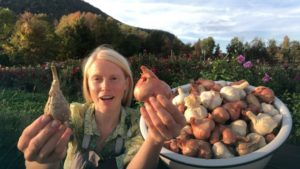We love to share what we love... and we love garlic and shallots! You'll find gorgeous seed garlic & shallots listed here every late Summer/early Fall. And don't forget the fertility... our Organic Garlic and Shallot Fertilizer has specially blended diverse amendments to feed both our soil and our alliums, and in turn, us!
Transcript: When I was a little girl growing shallots in my father’s garden, admittedly, we only grew shallots a few times; we always grew garlic and a lot of other things. But we grew shallots for a few years because I just thought they were really fun to grow. We grew these large Dutch Red types because they’re much more prolific productive, especially in our short seasons. Here in zone five compared to other shallots, like this Griselle or the French or grey type, that the French Griselles they are divine, they have a little more a higher sugar content. So it caramelized that much more crisp and divine is sweet. But, they’re much less productive. For example, they have a higher tendency to winterkill so be sure to plant them really deep and mulch them well. Where the French Greys, do Pardon me, the Dutch Reds are immensely productive and crazy cold tolerant so when you grow them in relatively poor soil, you’ll get five to one more or less. And our soil here at Fruition Seeds, we easily get 15 to one or more. They’re ludicrously productive.
So we’ll plant this one, and it will have this massive crown of shallots next summer. So, if you’re interested in productivity, by all means, do the Dutch Reds. They’re fantastic. If you really want to the exquisiteness of the flavor as all future shallot purists tend to fond be fond of the Griselles, the French Greys by all means give them a try, but I guarantee you will be eating 100 of these. That might be an exaggeration, you’re easily going to be eating dozens and dozens and dozens more of the dwarf Dutch Red compared to the French Greys, but now you know. Now you know, now you know.


